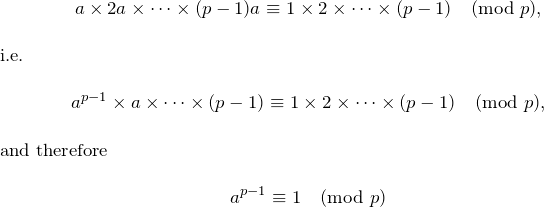If ![]() is prime, and
is prime, and ![]() , (i.e.
, (i.e. ![]() ) then
) then
(1) ![]()
Or equivalently, if ![]() is prime, then
is prime, then
(2) ![]()
Stated by Fermat 1640. Proved by Euler 1736, and by Leibniz (unpublished) about 50 years before that.
Proof
![]() means that
means that ![]() has an inverse
has an inverse ![]() , i.e. there’s a number
, i.e. there’s a number ![]() such that
such that ![]() .
.
The numbers ![]() also have inverses
also have inverses ![]() , because
, because ![]() is prime.
is prime.
Consider the remainders of ![]() on division by
on division by ![]() :
:
![]()
These are the numbers ![]() again in a different order, as they are nonzero and unequal
again in a different order, as they are nonzero and unequal ![]() , since
, since ![]() would imply
would imply ![]() . It follows that:
. It follows that:

Proof by induction (for ![]() )
)
1. When ![]() , obviously
, obviously ![]() .
.
2. Assuming ![]() is true for every prime
is true for every prime ![]() , prove
, prove ![]() .
.
From the binomial theorem,
![]()
Since ![]() divides each of the integers
divides each of the integers ![]()
![]()
We have assumed that ![]() , so
, so
![]()
QED